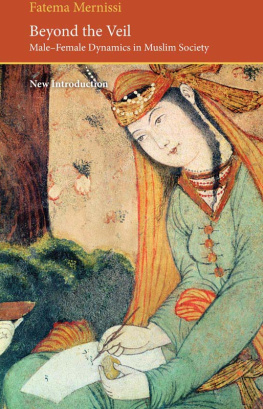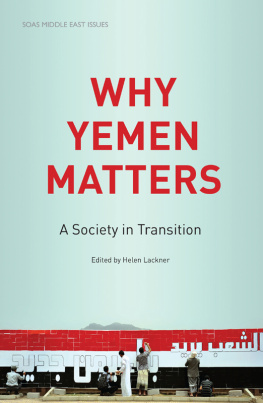ROUTLEDGE LIBRARY EDITIONS: WOMEN IN ISLAMIC SOCIETIES
Volume 2
CHANGING VEILS
Changing Veils
Women and Modernisation in North Yemen
Carla Makhlouf
First published in 1979 by Croom Helm Ltd
This edition first published in 2017
by Routledge
2 Park Square, Milton Park, Abingdon, Oxon OX14 4RN
and by Routledge
711 Third Avenue, New York, NY 10017
Routledge is an imprint of the Taylor & Francis Group, an informa business
1979 Carle Makhlouf
All rights reserved. No part of this book may be reprinted or reproduced or utilised in any form or by any electronic, mechanical, or other means, now known or hereafter invented, including photocopying and recording, or in any information storage or retrieval system, without permission in writing from the publishers.
Trademark notice : Product or corporate names may be trademarks or registered trademarks, and are used only for identification and explanation without intent to infringe.
British Library Cataloguing in Publication Data
A catalogue record for this book is available from the British Library
ISBN: 978-1-138-20332-7 (Set)
ISBN: 978-1-315-44956-2 (Set) (ebk)
ISBN: 978-1-138-69664-8 (Volume 2) (hbk)
ISBN: 978-1-315-52369-9 (Volume 2) (ebk)
Publisher's Note
The publisher has gone to great lengths to ensure the quality of this reprint but points out that some imperfections in the original copies may be apparent.
Disclaimer
The publisher has made every effort to trace copyright holders and would welcome correspondence from those they have been unable to trace.
CHANGING VEILS
Women and Modernisation in North Yemen
CARLA MAKHLOUF
1979 Carla Makhlouf
Croom Helm Ltd, 2-10 St John's Road, London SW11
British Library Cataloguing in Publication Data
Makhlouf Obermeyer, Carla
Changing veils.
1. Women Yemen San'' Attitudes 2. San'', Yemen Social conditions
I. Title
301.41'2'095332 HQ1730.5
ISBN 0-85664-502-8
Printed in Great Britain by
Biddles Ltd, Guildford, Surrey
This book is based mainly on field research in the city of San'a, the capital of North Yemen. As in all research, there are more people to thank than is possible.
I would like to thank Dr Robert Fernea of the Department of Anthropology of the University of Texas at Austin, who gave the initial encouragement for the publication of this book and later contributed many useful comments and suggestions. I am grateful to him, as well as to his wife, Elizabeth Warnock Fernea, for their interest in this project.
I would also like to thank the Center for Behavioral Research at the American University of Beirut and its director Dr E.T. Prothro for a grant covering travel expenses.
I am greatly indebted to the many women in Yemen whose hospitality and kindness made fieldwork an enjoyable are rewarding experience.
Most of all, my gratitude is to my husband. Through his own work on Yemen, he has laid the groundwork for this study and has provided many insights and key ideas as well as constant help and encouragement at all stages of this work.
In the shivers of her clothes are stories
Of yearning and desire and a charming world.
And she sees me from behind the veil,
And I know what is behind the veil.
Is she laughing at me
Or is she smiling to me...
(M. Al Sharaf, 1974 *)
*M. al Sharafi and A. al Maqli are contemporary Yemeni poets. (All translations from Arabic and French are my own.)
To my parents
This study tries to understand social change as it is experienced and perceived by women in San'a, the capital city of the Yemen Arab Republic. I have attempted to present a 'multidimensional' view of the process of change in its many diverse manifestations, rather than to concentrate on clear indicators of women's 'exploitation' and/or 'emancipation'. As a consequence, the study draws on a variety of sources, mainly, my observations of women's daily routine and ritual activities, of traditional seclusion and veiling patterns, and of modern institutions such as schools, hospitals and the mass media. My other sources of information include statements by women interpreting their own lives and their changing society, ideas about women and social change as they are expressed in newspaper articles, old legal manuscripts, radio and television programmes, and also some of the provocative work of contemporary Yemeni poets.
As an analysis of females in society, this study makes no claim to be uncovering an ignored subject: for studies of women, almost non-existent in the early seventies, have since then received a great deal of attention. With respect to the Middle East however, and especially the Arabian Peninsula, data and theory are less abundant. Where research has been done, it has concentrated on the most accessible and articulate groups in society, such as college students, educated housewives and women in the labour force. Little is known about females in highly traditional societies except what we can glean from the ethnographies of scholars who, for various reasons, had little or no access to the world of women. Perhaps one virtue of this study is that it focuses on women who have experienced various degrees of seclusion and veiling in a society which, until less than two decades ago, was only known to a few adventurous travellers and audacious merchants all of them males.
it is one of the six poorest nations of the world. Its Gross National Product was $36 million in 1958 and $811 million in 1973; its per capita income was $126 in 1973; 96 per cent of the Yemeni economy is based on agriculture. Foreign aid totals $432 million (Saint-Hilaire, 1975). The average life expectancy was estimated at 42.3 years in 1965-70 and infant mortality at 40 per cent in 1974. In 1971-2 there were 240 doctors for almost seven million inhabitants and illiteracy was as high as 67.25 per cent (Central Planning Organisation, 1973). Such bare facts have aroused the concern of a legion of aid and development agencies.
However, when we consider cultural achievement, Yemen boasts a tradition of complex architecture and elaborate craftsmanship, of legal sophistication and refined literature, which have flourished in urban centres and are also found in remote tribal areas. All these factors combine to define Yemen as a special case of modernisation and effectively challenge the comfortable notion that traditional culture is a constant in the broad scheme of development.
The central concern of this study is to see the relationship between objective and subjective aspects of social change, to consider not only the objective structural factors as they can be defined by an outside observer but also the subjective reality of change as it is lived and expressed by people in the society. In answering the question of how tradition comes to be questioned, challenged and ultimately transformed, I attempt to keep track of the everyday events as well as crisis points in the lives of the individuals experiencing the 'transition' and dealing with it. Such problems are the concern of much of the work of Peter Berger, and my debt to him will be obvious throughout this book.












